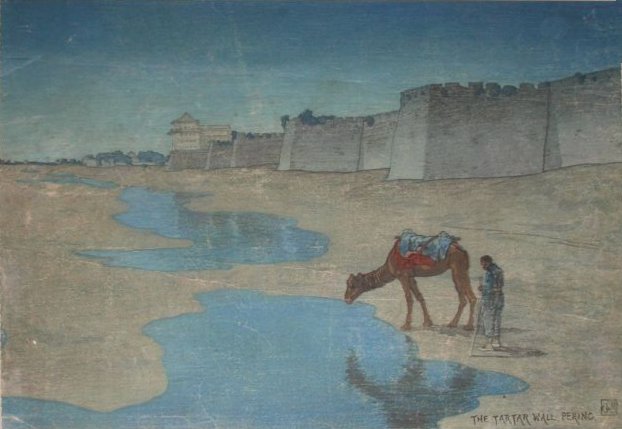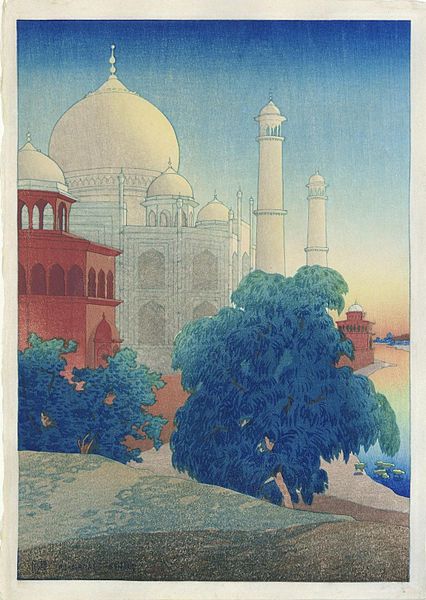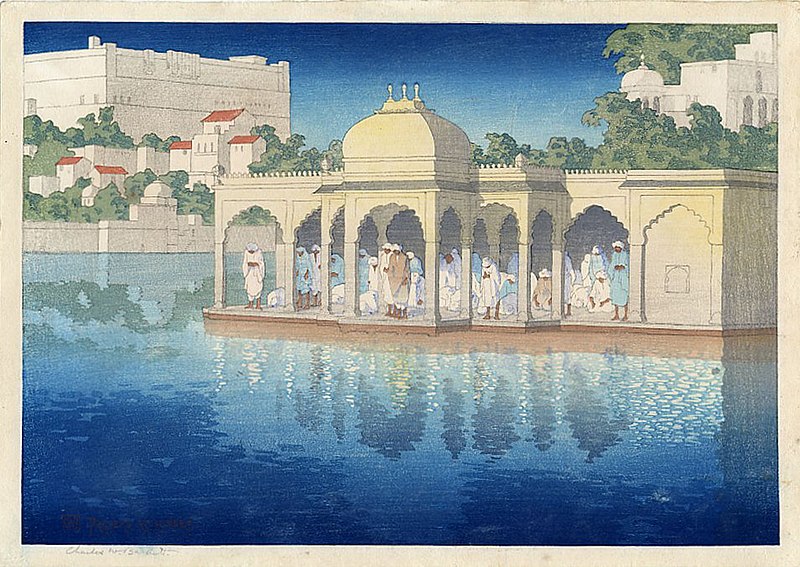.
Birds of paradise float in green lagoons,
while painted canopies stretch over Chinese couples
sunning themselves in gowns of feathered silk.
Palms from the Orient flower on banks of miniature islands
garnered in reeds and peony blossoms, bloomers
of white grace the flanks of a Javanese saint.
Boats are propelled by poles of bamboo,
held in the hands of dreamers, the holds are heavy
with fruit and dates, and they paddle through clouds
of azure drifting in canals of heaven.
John Wieners: Chinoiserie, 1965
while painted canopies stretch over Chinese couples
sunning themselves in gowns of feathered silk.
Palms from the Orient flower on banks of miniature islands
garnered in reeds and peony blossoms, bloomers
of white grace the flanks of a Javanese saint.
Boats are propelled by poles of bamboo,
held in the hands of dreamers, the holds are heavy
with fruit and dates, and they paddle through clouds
of azure drifting in canals of heaven.
John Wieners: Chinoiserie, 1965
Taj Mahal, twilight: Charles W. Bartlett, 1919, woodblock print (private collection)
Prayers at Sunset, Udaipur: Charles W. Bartlett, 1919, woodblock print (Honolulu Academy of Arts)









11 comments:
Lovely post!
It occurred to me that the artificial-paradise dreaminess of the woodblock prints of Charles W. Bartlett (1860-1940) might make a good match for the post-Symbolist dreaminess of John Wieners.
Bartlett, quoth the critical sage Lanny Quarles upon an earlier occasion, "seems to have a very nice take on the ukiyo-e style...that late 19th century uptake from the Japanese arts was phenomenally useful. The flatness gives it paradoxically a conceptual depth... a creamy dreaminess."
Bartlett, an Englishman, trained in the French academic studio style during the Impressionist period, became eventually one of the finest woodblock print artists in the Japanese ukiyo-e "floating-world" style.
After Bartlett's first wife and their child died in childbirth, he wandered Europe, gradually built a modest career for himself and remarried to the heiress of a Scots shipbuilding fortune. Traveling to the Far East in 1913 on his second wife's money, he encountered the Japanese publisher Shozaburo Watanabe, who had been creating reproduction prints of ukiyo-e artists.
Bartlett had probably had some prior acquaintance with the late 19th c. "Orientalist" tradition under his teacher in France, Boulanger. Watanabe had an interest in making new, original prints using the traditional ukiyo-e production method, involving collaboration of designer, block carver, and printer.
He took a look at Bartlett's watercolours and suggested they create woodblock prints. On Watanabe's instigation, Bartlett took formal training in the use of the Japanese style brush. Together they made several groups of prints. The first group included six scenes from India.
Bartlett ended up settling in Hawaii and becoming a happy printmaker with a hermitage in a lush green valley.
Tom,
Yes, how Bartlett's "'floating-world' style" resonates with Wieners' "dreamers . . . paddl[ing] through clouds
of azure drifting in canals of heaven." Do you know whether there's any connection between this Bartlett and the Bartlett collection in the Art Institute of Chicago?
3.6
light coming into sky above still black
ridge, white of waning moon in branches
in foreground, sound of wave in channel
the physical look, approach
“not forgotten world”
diagrammed, these paintings
then, become material
clouds against shadowed canyon of ridge,
grey whiteness of sky across from point
Living in Sausalito has made me want to take up woodblock printing. Also hermiting.
The background information you supply explains my initial thought that the top image was by Utagawa Hiroshige.
I still remember my introduction to the poetry of Wieners. (I've never taken a course in poetry, so there are gaping holes in my knowledge and experience here, which makes the encounters often that much more intense.) I was in a seminar session at the University of Glasgow, relatively intoxicated from a midday session at a local establishment, when a Scottish professor of American literature began reading Wieners "A Poem for Record Players." Arguably, I might have been happy listening to him read Robbie Burns after a bad haggis, but Wieners voice sung to me that day. I spent the night pouring over the print-out of the poem, and scribbling this, which I still read with some bit of joy.
Many thanks Maureen, Steve, Nora, Brad.
John hasn't been gone so long really, why does it feel like... centuries?
We began a correspondence in the early-to-mid-60s. John was then living on Joy Street, Boston. He sent me poems, I was able to publish some of them.
Here's one I've always liked:
John Wieners: My Mother
My dream for the day, to take up a hermitage on a houseboat on a tranquil bay, and there make gentle, gauzy woodblock prints for the remainder of my days.
That's a good day dream to have.
A poem lit with grace. A picture.
I hadn't heard of Bartlett before. This is the place to learn new things.
Yes, Bartlett does seem pretty much a private interest -- though a few others to whom I've shown his woodblock prints have admired them as well. He has another series featuring surfers and divers, a subject he handles with the confidence and skill of a familiar.
John's lovely poem perhaps belongs in the genre of dream-manufacture one associates with Baudelaire and Coleridge, though with a wink of complicity to the reader rarely to be found in either of those poets.
I'm put in mind of Coleridge's (surely inadvertent) double-entendre line-break, "...he breathed/In pants" -- evoking (in this reader anyhow) the involuntary reaction, "Well, I should hope so!"
But when John writes, "bloomers/of white grace the flanks of a Javanese saint," one can't but sense an element of conscious camp mixed in with the aethereal elegance. Ooh, those snowy-white bloomers!
Dear Tom
Many Thanks for this poem and the woodblock prints.
I remember spending a long time with my mother in that top image. The scene was very similar. Tho I do not remember the few banana trees visible
The scene since then has been infiltrated by were a number of tourists out on excursions in the lake in the hired water boats.
Local photographers next to their camels and carrying bags of traditional dresses constantly offer better and better discounts to the couples.
Other locals simply sleep in the tree shade.
The Lake Palace visible in distance is a fie star hotel now.
Aditya,
Many thanks for the local knowledge.
Ah, to sleep in the tree shade!
You will recall this previous JW poem, available here at discount if one acts now.
John Wieners: My Mother
Thank you for sending me that way again. And what a truly terrific journey I've had. Re-read the whole series of three Mother poems followed by Philip Larkin's advice on parentage
then over to Philip Whalen's beautiful mountains
finally culminating with The Mausoleum of Humayun
which being the architectural predecessor of Taj Mahal.. back to the amazing woodblock prints. A Full Circle!
Post a Comment